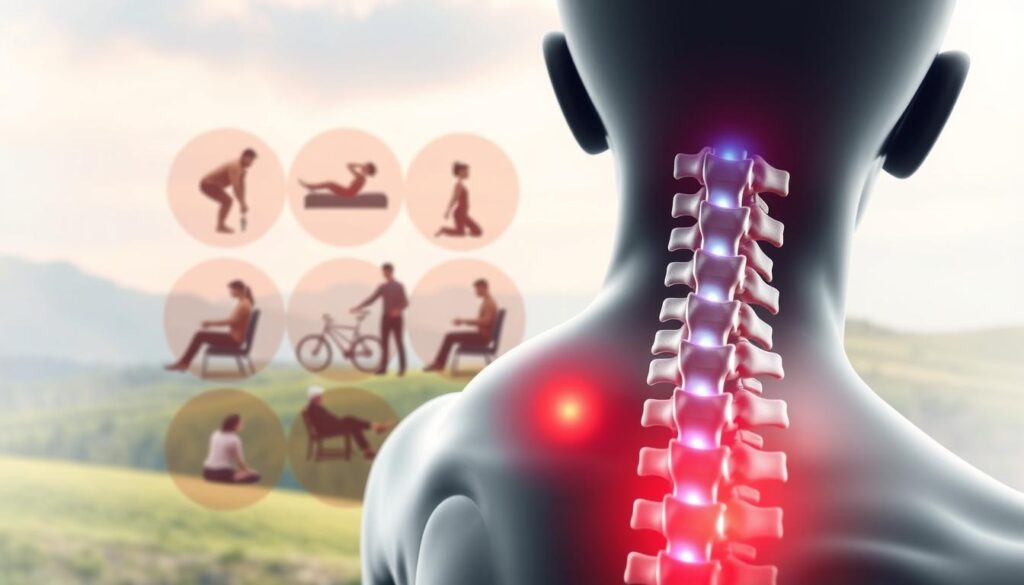Discover How to Avoid Back Surgery Today
Chronic discomfort doesn’t have to lead straight to the operating room. This article shares practical, expert-backed strategies to help you manage persistent pain and explore alternatives to invasive procedures. While procedures like spinal fusion are sometimes necessary, research shows many patients find relief through conservative methods.
Physical therapy, targeted exercises, and lifestyle adjustments often play a crucial role in recovery. Leading spine specialists agree: understanding your options empowers better decisions about your health. We’ll break down emerging treatments and daily habits that can reduce reliance on drastic measures.
You’ll learn about minimally invasive techniques gaining traction in medical circles, plus how simple changes to your routine can protect your spine. Our goal? To provide clear information that helps you take control of your well-being with confidence.
Key Takeaways
- Non-invasive treatments often work as effectively as surgery for chronic discomfort
- Spinal procedures carry risks like extended recovery times and complications
- Expert-recommended methods include physical therapy and posture correction
- Lifestyle changes can significantly improve spinal health over time
- New medical advancements offer alternatives to traditional operations
Understanding Chronic Back Pain and the Risks of Surgery
Millions of Americans experience persistent spinal issues each year, yet only a fraction require invasive procedures. Recognizing the difference between temporary strain and chronic conditions helps patients make informed choices about their care. Let’s explore what defines lasting discomfort and why surgical interventions demand careful consideration.
What Constitutes Back Pain?
Back pain typically involves discomfort in muscles, bones, or nerves along the spine. Acute cases often resolve within weeks, but chronic pain persists for three months or longer. Symptoms like radiating numbness or limited mobility frequently signal underlying issues such as herniated discs or arthritis.
Bryan Hathaway, a leading pain specialist, notes: “Chronic discomfort often stems from multiple factors, including posture habits and nerve irritation.” This complexity means treatment plans must address both physical causes and lifestyle contributors.
Potential Surgical Complications
Spinal operations carry higher risks than many patients realize. Common concerns include:
- Infections requiring additional treatments
- Nerve damage leading to numbness or weakness
- Scar tissue causing “failed back surgery syndrome”
The American Society of Anesthesiologists reports up to 40% of procedures may not achieve desired results. Surgeries near the spinal cord heighten these risks, as even minor errors can impact critical nerve pathways.
Individual health factors like fitness levels and nutrition also influence recovery. With these variables, exploring conservative options first often proves wise. Next, we’ll examine why many physicians recommend non-surgical approaches for lasting relief.
Reasons to Consider Avoiding Back Surgery

Medical decisions about spinal health require careful thought. While operations can help some, they’re not a guaranteed fix. Factors like age, existing health issues, and activity levels heavily influence recovery success.
Risk Factors and Uncertain Outcomes
Surgeons often warn that spinal procedures carry higher risks for older adults or those with diabetes. A recent analysis found 1 in 5 patients develop infections or blood clots after major operations. Even successful fusions might limit mobility, creating new discomfort.
Dr. Bryan Hathaway explains: “Every body responds differently. What relieves pain for one person could cause stiffness or nerve irritation in another.” This unpredictability leads many physicians to recommend physical therapy first.
When Surgery Might Worsen Symptoms
Certain conditions like scar tissue buildup or chronic inflammation often react poorly to invasive treatments. Failed procedures sometimes create “domino effects,” where compensating for stiffness strains other spinal areas. Non-surgical methods like targeted exercises or posture adjustments frequently yield better long-term results without hospital stays.
New research shows 65% of chronic pain cases improve through conservative care. As we’ll explore next, small daily changes often make the biggest difference in spinal health.
Lifestyle Changes for a Healthy Spine
Your daily habits hold surprising power over spinal health. Research shows simple adjustments can reduce discomfort and help many patients sidestep drastic measures. Dr. Scott Nimmons emphasizes: “Small, consistent changes often outperform short-term fixes—especially for chronic pain.”
Fueling Recovery Through Daily Choices
Anti-inflammatory foods like leafy greens and fatty fish combat swelling that worsens back pain. A Johns Hopkins study found adults who combined Mediterranean-style eating with light exercise reported 70% less discomfort over six months. Key strategies:
- Maintain healthy weight to reduce lumbar pressure
- Stay hydrated to keep spinal discs supple
- Add magnesium-rich foods to relax tense musclese
Movement as Medicine
Strengthening core muscles creates natural support for your spine. Try these therapist-approved moves:
- Planks (start with 20-second holds)
- Bird-dog stretches for balance
- Pelvic tilts to ease lower back pain
Posture corrections matter too. Occupational therapist Lena Torres notes: “Slouching strains spinal ligaments equivalent to lifting 30 pounds repeatedly.” Ergonomic work setups and frequent stretch breaks prevent cumulative damage.
These changes build resilience against flare-ups. Up next: how physical therapy and other hands-on approaches complement lifestyle shifts.
Conservative Therapies as Alternatives

Exploring non-invasive solutions first could be your safest path to lasting relief. Many patients see significant improvement through methods that address root causes rather than symptoms. These approaches often work best when combined, creating a ripple effect of healing.
Movement-Based Healing
Physical therapy strengthens muscles while improving flexibility—key factors in spinal health. Therapists often use TENS units to block pain signals, paired with exercises like pelvic tilts or cat-cow stretches. A JAMA study found 68% of participants reduced discomfort through structured programs without needing procedures.
Natural Tension Relief
Swedish massage eases surface muscles, while deep tissue work targets stubborn knots. Acupuncture takes a different route, stimulating nerves to release natural painkillers. Research shows these methods increase blood flow by up to 40%, speeding up tissue repair.
Combining therapies often yields the best results. For example, weekly acupuncture sessions paired with daily stretching can break the cycle of stiffness. As one clinic director notes: “Our clients who stick with conservative care typically regain mobility faster than those who rush into operations.”
Effective Steps to AVOID BACK SURGERY
Making smart choices about spinal care begins with personalized evaluation. Experts like Dr. Scott Nimmons suggest assessing your unique situation before considering any procedure. Physical therapy and lifestyle adjustments often provide better long-term results than rushed decisions.
Evaluating Your Suitability for Surgery
Ask your doctor these key questions:
- Could existing health conditions increase risk during recovery?
- What alternative treatments haven’t we tried yet?
- How will this affect my ability to work or exercise?
Bryan Hathaway notes: “Patients with active lifestyles often respond better to movement-based therapies than invasive solutions.” Recent data shows 58% of cases improve through six months of conservative care.
Implementing Non-Invasive Treatments
Start with these evidence-backed strategies:
- Three weekly therapy sessions focusing on core strength
- Anti-inflammatory nutrition plans
- Progress tracking through pain journals
A 2023 study revealed patients who combined these methods reduced pain by 62% within 90 days. Remember – consistency matters more than intensity. Small daily improvements create lasting change.
Innovations in Non-Surgical Interventions
Recent breakthroughs are transforming how we approach spinal care without major operations. Advanced techniques now target problem areas with precision, reducing tissue damage and speeding healing. These methods blend cutting-edge technology with proven rehabilitation strategies for lasting results.
Smaller Tools, Bigger Impact
Endoscopic spine procedures use pencil-sized instruments to address disc issues through incisions smaller than a dime. A 2023 Spine Journal study showed these methods cut recovery time by 60% compared to traditional approaches. Dr. Emily Carter, a pioneer in laser disc treatments, notes: “We’re achieving better outcomes with less disruption to muscles and nerves.”
New fusion techniques use biocompatible materials that encourage bone growth while minimizing hardware. Targeted decompression relieves nerve pressure without removing entire spinal sections. Patients typically resume light activities within days rather than weeks.
Over 78% of people undergoing these procedures return to work faster than with conventional methods. Combined with personalized physical therapy plans, they help maintain mobility during healing. Many clinics now pair these advances with posture-focused exercise programs to prevent future strain.
As technology evolves, so do options for lasting relief. These innovations prove that effective spinal care doesn’t always require drastic measures.
Conclusion
Taking charge of your spinal health starts with understanding your options. As this article highlights, many cases of persistent discomfort respond well to non-invasive methods. From targeted exercises to anti-inflammatory nutrition, small daily choices create lasting change.
Research confirms that approaches like physical therapy and posture correction often outperform invasive procedures. Innovations in laser treatments and endoscopic techniques now offer precise relief with faster recovery times. Dr. Emily Carter’s work shows how modern medicine prioritizes preserving mobility while addressing root causes.
Every condition differs, but experts agree: exploring conservative options first reduces risks. Discuss personalized plans with your care team, weighing benefits of methods like massage therapy or core-strengthening routines. Tracking progress helps identify what works best for your body.
Remember – relief doesn’t always require drastic steps. With today’s advances and proven strategies, managing pain effectively becomes an achievable goal. Your journey to a stronger spine begins with informed choices and consistent care.
